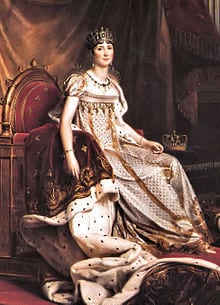Josephine Beauharnais timeline

Courtesy Wikimedia Commons
Introduction – Josephine Beauharnais Timeline
Josephine Bonaparte, born Marie Josèphe Rose Tascher de La Pagerie on June 23, 1763, in Les Trois-Îlets, Martinique, was a woman of extraordinary grace, beauty, and influence. She is best known as the first wife of Napoleon Bonaparte, who would later become Emperor of France. However, Josephine’s own life story is equally fascinating and full of intrigue.
Josephine was born into a wealthy plantation-owning family in the French colony of Martinique. From a young age, she was known for her beauty and charm, and she was often the center of attention at social gatherings. She was married at the age of 16 to Alexandre de Beauharnais, with whom she had two children.
Sadly, Alexandre was executed during the French Revolution, leaving Josephine a widow with two young children to care for. In 1795, she met the rising military star Napoleon Bonaparte, and the two quickly fell in love. Despite their differences in age and background, the couple married in 1796.
As Napoleon rose to power and eventually became Emperor of France, Josephine became one of the most influential women in Europe. She was known for her impeccable sense of style and fashion, as well as her patronage of the arts and support for charitable causes. She played a key role in Napoleon’s court, hosting lavish balls and diplomatic gatherings that helped solidify his power.
However, Josephine’s greatest passion was her love of plants and gardens. She was an avid botanist and horticulturist, with a particular interest in exotic plants from around the world. She created one of the most famous gardens in Europe at her residence, Malmaison, where she cultivated a vast collection of rare and unusual plants.
Josephine’s passion for plants was not just a hobby, but a serious scientific pursuit. She corresponded with leading botanists of the day, exchanging seeds and specimens with them to add to her collection. She also sponsored expeditions to gather new plant species from distant lands, contributing to the discovery and classification of many new species.
One of Josephine’s most famous botanical achievements was her cultivation of roses. She was especially fond of roses, and she amassed a collection of over 250 different varieties at Malmaison. She employed a team of gardeners to care for her roses, experimenting with different techniques to produce new and unique hybrids.
Josephine’s love of plants and gardens reflected her appreciation for the natural world and her desire to create beauty and harmony in her surroundings. Her gardens at Malmaison were renowned for their beauty and elegance, attracting visitors from across Europe who came to admire the exotic plants and exquisite landscaping.
In addition to her botanical pursuits, Josephine was also known for her philanthropy and support for the arts. She established schools for orphaned children, hospitals for the sick and wounded, and charity organizations to help the poor and disadvantaged. She also patronized artists, musicians, and writers, fostering a vibrant cultural scene in Paris during the height of Napoleon’s reign.
Despite her many accomplishments, Josephine’s life was not without tragedy and heartbreak. She and Napoleon were unable to have children together, and their marriage eventually ended in divorce in 1810. Josephine was forced to retire to Malmaison, where she lived out the rest of her days in relative seclusion, surrounded by her beloved plants and gardens.
Josephine Bonaparte passed away on May 29, 1814, at the age of 50. She left behind a legacy of beauty, elegance, and sophistication that continues to inspire admirers around the world. Her passion for plants and gardens was just one aspect of her remarkable life, but it was a reflection of her deep connection to the natural world and her desire to create beauty and harmony in the world around her (AI -GPT-4o).
Josephine Beauharnais Timeline
1798 – Josephine purchases Château de Malmaison while Napoleon leads the French army on a campaign in Egypt>
1800 -The European plant obsession ‘botanophilia‘ reaches its height>
1800-1803 – Napoleon orders the Baudin & Hamelin expedition to the South Seas
1803 – Publication of Jardin de Malmaison an illustrated account of plants growing at Malmaison, by Pierre-Joseph Redouté
1803-1806 – Charles-Francois Mirbel appointed Superintendant Gardener at Malmaison>
1804 – Josephine crowned Empress of France by Napoleon in Notre Dame
1806-1808 – Jean-Baptiste Louis le Lieur replaces Mirbel
1804-1807 – Labillardière publishes Novae Hollandiae Plantarum Specimen
1804-1814 – Assemblage of horticultural collections at Malmaison, in particular the rose and Nouvelle Hollande collections>
1808-1814 – With the death of Ventenat, Bonpland takes over as Botanist & Conservator at Malmaison>
1811 – Shares cost of plant collection by Scotsman James Niven at the Cape of Good Hope with English nurserymen Lee & Kennedy>
1814 – Napoleon exiled to Elba, escapes to Paris where he assembles army
1815 – Napolean defeated by a coalition of English and Prussian armies at Waterloo, banished to St Helena, the end of French Empire coming with the signing of the Treaty of Paris: his letter of surrender to the British throws him to their mercy ‘like Themistocles‘
1817-1824 – Publication of Les Roses by botanical illustrator Pierre-Joseph Redouté
—
First published on the internet – 1 March 2019
The four phases of human existence. Image courtsy Rob Cross, January 2019


